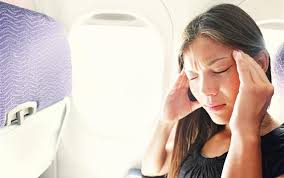Air travel: what altitude does to your ears
August 21st, 2018 José Sitbon No Comment Wellness
In mid-July, a Ryanair Boeing 737 between Ireland and Croatia had to land in an emergency at Frankfurt, Germany, due to a depressurization of his cabin. Following this trying episode, 33 passengers had to be hospitalized because their ears were bleeding.
Why did this rapid descent cause bleeding?
Altitude, pressure and Eustachian tube
 Aircraft usually fly above 9,000 metres in altitude, a height reached by climbing or descending at about 600 meters per minute. At this altitude, atmospheric pressure outside of the device is only a third of the one at sea level. Consequence: the gases expand.
Aircraft usually fly above 9,000 metres in altitude, a height reached by climbing or descending at about 600 meters per minute. At this altitude, atmospheric pressure outside of the device is only a third of the one at sea level. Consequence: the gases expand.
For comfort and safety reasons, the aircraft cabins are « pressurized » to a pressure of equivalent to those between 1 500 and 2 500 metres above sea level. This pressure is thus weaker than that which exists at sea level. Which is why when you take a packet of chips in flight, this one seems about to explode, or that on arrival, your bottle of shampoo sank into your bag. This pressurization also maintains the oxygen concentration in the cabin at a level sufficient for the passengers.
Normally, as the aircraft rises, the air in the inner ear is at a pressure above the air in the cabin. It is still at the pressure that existed at ground level during take-off.
This pressure difference causes the eardrum to swell.
Conversely, when the aircraft descends, the air pressure in the cabin gradually increases to towards the one that exists at sea level. But in the inner ear, the pressure remains the same as the lower one that existed during the flight. This time, the eardrum is pushed inward. The sounds You may already have experienced this feeling on an airplane.
During a normal ascent and descent, sucking on candy, drinking or yawning can help open the trunk. Eustachian (the duct that connects the middle ear to the back nose), which is normally closed. L’ouverture at the back of the nose widens, allowing the pressure in the inner ear to balance with the pressure in the outer ear. outside.
Other unpleasant side effects
Fortunately, the kind of misfortune experienced by passengers on flight FR7312 is rather rare. Transport 2017 was the safest year in the history of civil aviation).
However, even if things go well, the flights will probably never be totally agréables…
If everyone experiences hearing problems (disturbed hearing, cracking ears), these are particularly unpleasant for people who travel with a cold: their sinuses are full of mucus, which blocks the opening of their Eustachian tubes… The teeth of passengers can also make them suffer during or after the flight, because the air contained in the fillings and around the nerves expands and contracts as pressure changes. Unfortunately, unlike the earaches, chewing gum or sucking candy will not help.
And ears or teeth are not the only parts of the body that are affected by the decrease in air pressure: this is also the case for gases contained in the intestine. These expand as the aircraft increases in altitude, then are compressed again as they descend. They then look for a place to escape. At this point, passengers often find themselves faced with a cruel dilemma: choose between physical and social discomfort… To address this well-known problem, a group of researchers suggested incorporating activated carbon into aircraft seats to absorb the odors.
If perfection is not achieved, it is always possible to improve the experience…
On the same subject
The Vaccine: still an essential for Tourism ?
Europeans are the most sceptical in the world about vaccine safety, according to an...
Seattle vibrates to the rhythm of jazz for the Earshot Jazz Festival
From October 4 to November 6, 2019, Seattle will be hosting the 31st edition...
The TUI Group publishes its latest sustainability report : « Better Holidays, Better World »
The TUI Group, the world leader in tourism, has published its 2018 Sustainable Development...










